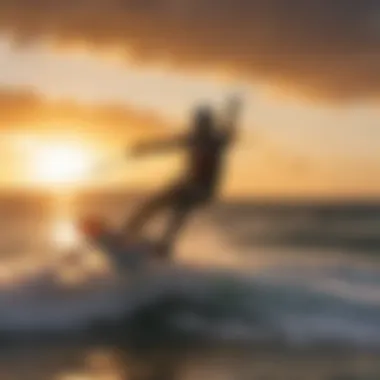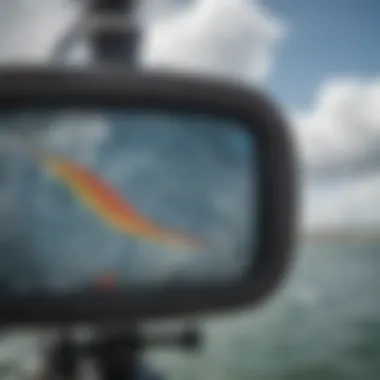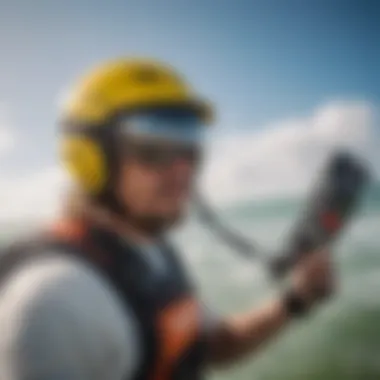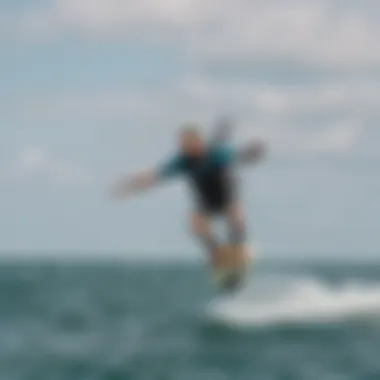Kiteboarding Conditions and Forecast at Port Canaveral


Intro
For kiteboarding enthusiasts, finding the optimal conditions can make all the difference between a mediocre outing and an exhilarating experience on the water. Port Canaveral, with its unique combination of winds, tide patterns, and environmental factors, offers a playground that caters to all skill levels. This article cuts through the noise, peeling back the layers to reveal vital insights into the marine forecast, aiming to enhance the kiteboarding experience.
Understanding how weather influences the waves is crucial. It’s not merely about grabbing the board and hitting the water; careful consideration of meteorological elements can fundamentally shift your kiteboarding performance. Information regarding wind patterns, tides, and even local flora and fauna can shape your experience. Whether you're an aspiring kiter or a seasoned pro, the nuances of Port Canaveral’s marine forecast hold the keys to maximizing your time on the water.
Gear Insights
When it comes to kiteboarding, having the right gear is half the battle won. Your choice of kite, board, and accessories plays a pivotal role in how you tackle the waters of Port Canaveral.
Latest Gear Reviews
In recent years, several productions have hit the market that cater specifically to kiteboarders venturing into fresh waters. Brands like Naish, Cabrinha, and Duotone have consistently showcased advancements in design and technology. Consider the Naish S26 Pivot, which is hailed for its versatility and responsiveness across a variety of conditions. Meanwhile, Cabrinha’s Contra line has drawn attention for those seeking a powerful, steady ride in lighter winds. These models tend to balance performance with user adaptability, making them suitable choices for different level kiteboarders.
Another notable mention is the Duotone Jaime board, often praised for its all-around capabilities and smooth ride. Whatever your personal preference, always look for reviews and firsthand experiences from fellow kiteboarders to gauge the practical performance of gear in real-world conditions.
Essential Gear for Beginners
Starting your kiteboarding journey requires a thoughtful approach regarding equipment. Here’s a distilled list of the essentials:
- Kite: A beginner should opt for a user-friendly kite. Look for stability and easy relaunch capabilities.
- Board: A larger board offers better float and stability, which can ease the learning curve.
- Harness: Make sure you have a comfortable harness that fits well; this will directly affect your control.
- Safety Gear: Don’t skimp on safety. A helmet and impact vest can absorb some of the shocks of inevitable falls.
For those stepping into the realm of kiteboarding, familiarizing yourself with the local conditions and respecting safety concerns is paramount.
"Knowledge is power, and in kiteboarding, understanding weather patterns could be your strongest ally."
Techniques and Tips
Once you've mastered the basics and kit out properly, it’s time to elevate your game with advanced techniques and safety practices.
Advanced Tricks and Techniques
For those who’ve kicked it up a notch, tricks such as the backloop and darkslide can add flair to your ride. Practicing these maneuvers not only improves your technical skills but also boosts your confidence on the water. Remember, understanding your kite’s response to inputs like speed and pressure is crucial for executing these tricks successfully.
Safety Practices for Kiteboarders
While the thrill of kiteboarding can sometimes overshadow the need for caution, it's fundamental to adhere to established safety practices:
- Always check the forecast before heading out. Know the wind speed and direction.
- Keep an eye on the tide charts to avoid unexpected hazards.
- Use a buddy system whenever possible, especially for beginners.
By immersing yourself in the marine forecast specifics and building upon foundational skills, you not only enrich your own kiteboarding experience but contribute to the wider community's safety and enjoyment.
Understanding Marine Forecasts
When it comes to kiteboarding at Port Canaveral, grasping the ins and outs of marine forecasts can mean the difference between a thrilling experience and a day spent grappling with less-than-ideal conditions. Whether you’re a seasoned pro or just dipping your toes into the sport, a solid understanding of marine forecasts enhances your ability to make informed decisions about when and where to hit the water.
Navigating through wind speeds, wave patterns, and weather shifts equips kiteboarders with the knowledge necessary to stay safe and seize the best opportunities. It's essential to grasp not just the numbers but what they translate to in real-world terms — after all, that’s where the fun thrives.
Definition and Importance
A marine forecast can be broadly defined as a prediction of weather conditions over oceans, seas, and coastal regions. For kiteboarders, this prediction plays an incredibly pivotal role. It's like a compass guiding every outing. You’ll often hear about wind speed, wave height, and tide times, but the crux lies in understanding how these factors interrelate and influence your adventure on the water.
For instance, kiteboarders favor steady winds that fall within certain thresholds, usually between 12 and 25 knots. Anything below can leave you stranded, while anything above can be daunting. This is why understanding marine forecasts is not just an exercise in data-reading but a practical tool to maximize enjoyment while keeping risks at bay. If you can predict a gusty day, it might be best to swap the kite for a beach day instead.
Components of a Marine Forecast
The components of a marine forecast are like the ingredients in a recipe — you need them all to create a successful kiteboarding experience. Here are key elements:
- Wind Direction and Speed: This dictates your performance. Cross-shore winds are usually the most favorable.
- Wave Height and Period: Understanding the wave conditions helps kiteboarders anticipate how the water will behave.
- Tides: Tidal patterns can alter safety and accessibility at various spots along the coast. High tides might push water into unwanted areas, while low tides may expose hazards.
- Sea Surface Temperature: Cooler waters can impact performance and comfort levels.
- Weather Conditions: Knowing if a storm is on the horizon or if it’s a clear day helps to plan your session efficiently.


Each of these components interacts in a delicate dance. For example, a moderate wind can be just what’s needed when paired with the right wave height, creating perfect conditions for a fun day out. Kiteboarders who can dissect these forecasts into actionable insights will inevitably have a richer, more rewarding experience on the water.
"Understanding the weather helps us sharpen our skills, but it also empowers us to safely navigate the thrills that kiteboarding brings."
By keeping these components in mind, you can strategize your kiteboarding excursions better and align them with Mother Nature’s moods, ensuring you make the most of every outing.
Analyzing Port Canaveral's Unique Conditions
Understanding the local conditions is a key ingredient for a successful kiteboarding experience in Port Canaveral. Kiteboarders of all levels benefit from a nuanced perspective on how the area's unique geographic traits and tidal shifts apply to their time on the water. These factors play a crucial role in determining weather patterns and ensuring safety, making it essential for anyone looking to ride the winds with confidence.
Geographic Influences on Weather Patterns
When considering kiteboarding at Port Canaveral, one must acknowledge the geographical layout that significantly influences its weather dynamics. The area's coastal topography, marked by coves and inlets, can create localized wind patterns that differ sharply from predictions made by generalized forecasts. Understanding these nuances can be likened to having an insider's guide to the best spots for flying a kite.
The proximity to the Atlantic Ocean results in a prevalent easterly trade wind, which generally provides excellent conditions for kiteboarding. Between the winds swirling around the Cape, the unique coastal shape helps funnel gusts, often creating ideal spots right off the beach. The local topography, therefore, can both enhance and sometimes inhibit wind flow, depending on temperature variations.
Moreover, seasonal changes play their part, as summer storms can introduce unpredictable gusts. Kiteboarders must stay alert and adapt to shifts in the atmosphere. Knowledge of how high-pressure systems move and their effects on local breezes is crucial.
Tidal Fluctuations and Their Impacts
Tides also have their say in the spectrum of conditions experienced on the water. At Port Canaveral, the tidal range can be substantial, with differences between high and low tide affecting not just water depth but also the movement of currents. These currents significantly influence safety and maneuverability when kiteboarding. They can either make a session easier or lead to unexpected challenges.
During high tide, for instance, certain spots may become overcrowded, making navigation tricky. At low tide, emerging sandbars can create ideal flat-water conditions that are often favored by beginners and those wanting to practice new tricks. Understanding tidal schedules, therefore, is essential for selecting the right time to hit the water. It means knowing not just when but where to kite, enhancing the overall experience by avoiding common pitfalls.
"The best kiteboarding experiences come not just from the wind but from understanding how the water moves and changes."
For a kiteboarder, the goal should be to become attuned to these environmental rhythms. Observing local seasoned kiteboarders and participating in community discussions can provide invaluable insights into mastering Port Canaveral’s unique conditions. Whether it's a whisper in the air suggesting an incoming breeze or a sudden shift in the tide, being aware equips you to navigate your kiteboarding adventures, ensuring not just fun but also safety, which is paramount.
Key Weather Factors for Kiteboarding
Understanding the various weather factors is essential for anyone looking to kiteboard at Port Canaveral. These elements don't just dictate how thrilling the ride will be, but they also play a significant role in ensuring safety. The right conditions can make the difference between a day of exhilarating fun and facing dangerous situations on the water. In this section, we will delve into three critical factors: wind patterns, wave height, and temperature, each woven into the fabric of every kiteboarding session.
Wind Patterns and Speeds
The life-blood of kiteboarding is undoubtedly wind. Port Canaveral's gusts can vary dramatically based on both time and location. Kiteboarders need to grasp not only the wind speed but also its direction. For instance, a side-onshore wind is often ideal because it allows for both control and enough power to lift off.
- Optimal Wind Speed: Generally, a wind speed between 12 to 25 knots is considered suitable for most riders. Too little wind means sluggish movement, while too much wind can result in loss of control.
- Patterns Throughout the Day: Wind conditions tend to shift as the day progresses. Early mornings might boast lighter breezes, making it preferable for beginners, while afternoons can whip up to send seasoned riders soaring.
Additionally, local topography can affect wind flow. Areas sheltered by buildings or dunes can experience lower winds. A growing number of kitesurfers in the local community often share tips online, such as on platforms like Facebook or Reddit, to help each other scout the perfect spots.
Wave Height and Frequency
Wave conditions fundamentally change one's experience while kiteboarding. At Port Canaveral, the unique tide patterns influence wave heights, impacting how one maneuvers across the water.
- Wave Height: Generally, lower wave heights (1 to 3 feet) provide a smoother ride, particularly for less experienced riders. On the flip side, larger waves (above 4 feet) can be both exhilarating and challenging for advanced kiteboarders looking for adrenaline.
- Frequency of Waves: Wave frequency—how often waves come crashing in—plays a crucial role in ride stability. A rhythmical pattern signifies a smoother experience, contrast to erratic waves which can create unsettling conditions.
Understanding the tidal influences can help kiteboarders choose their timing wisely, capitalizing on those swells for maximum enjoyment.
Temperature and Humidity Considerations
Temperature and humidity may not seem directly related to kiteboarding performance, but they have significant implications for comfort and safety.
- Ideal Air Temperature: Kiteboarders generally favor mild temperatures around 70°F to 85°F. Anything outside this range can impact endurance and responsiveness.
- Humidity Levels: High humidity can lead to fatigue, trapping heat and making it uncomfortable for prolonged sessions. Monitoring the local weather can prevent overestimating one's ability to stay active in such conditions.
Moreover, dressing appropriately cannot be overstated. Wearing lightweight materials that allow for breathability can significantly improve comfort levels while out on the water.
In summary, being aware of the key weather factors—wind patterns, wave conditions, and temperature—provides an edge for kiteboarders, allowing for not only better performance but a safer, more enjoyable adventure at Port Canaveral.
"The most important thing in kiteboarding is knowing that wind is your friend but also understanding that it can be an adversarial force if conditions aren't right."
Knowing how to navigate these elements can vastly change any kiteboarding experience, making each venture into the waves both safe and exhilarating.


Utilizing the Forecast for Optimal Kiteboarding
Understanding how to utilize marine forecasts effectively can vastly enhance the kiteboarding experience at Port Canaveral. Kiteboarding is not just about having the right gear and skills; it's about reading the conditions and making smart, timely decisions. Good forecasts help kiteboarders know when to hit the water or when to play it safe. This section explores the intricacies of interpreting forecast data, selecting suitable equipment, and timing your kiteboarding sessions for the most favorable conditions.
Interpreting the Forecast Data
When it comes to marine forecasts, interpreting the data can sometimes feel as complex as understanding a foreign language. However, once the basics are grasped, it becomes second nature. Key components to consider include:
- Wind Speeds: Generally measured in knots, it signals the strength of the wind. For kiteboarding, most prefer wind speeds between 12 to 25 knots, depending on their skill level and equipment.
- Wind Direction: This is crucial. Knowing if the wind is coming from the north, east, or south—and at what angle—could make or break your session. A consistent wind direction leads to smoother rides.
- Wave Height: Especially for intermediate to advanced kiteboarders, understanding how wave height interacts with wind can aid in choosing their riding style. A flat surface is ideal for beginners, while experienced riders may seek out waves for more challenging experiences.
Engaging with platforms like Reddit for local insights can also shed light on forecast interpretation from those who know the waters well. Kiteboarding communities often discuss their experiences based on real-time data, providing a practical edge.
Choosing the Right Gear Based on Conditions
Selecting appropriate gear for kiteboarding varies drastically depending on the environmental conditions. It’s a bit like cooking; the ingredients must complement each other!
- Kite Size: This varies with wind conditions. Light winds call for larger kites, while stronger winds require smaller ones. For instance, a 12-meter kite might be ideal for 12 to 15 knots, but if the wind picks up to 25 knots, you’d likely want a 7-meter kite.
- Board Type: Freeride boards are perfect for cruising but may struggle in rough water. Conversely, kiteboarders aiming to catch waves may prefer a surfboard style, which handles chop better.
- Safety Gear: Never overlook safety equipment like impact vests and helmets. They might not necessarily improve your performance, but they can certainly enhance your safety.
Incorporating the right gear significantly heightens enjoyment and safety, especially when conditions take an unexpected turn.
Timing Your Sessions for Best Conditions
Timing those kiteboarding sessions is an art of its own. Tides, winds, and even local weather phenomena work together to determine the ideal time for getting on the water. Here are some pointers to keep in mind:
- Tide Considerations: At Port Canaveral, tide movements can greatly influence water conditions and safety. Riding during high water levels often provides better conditions due to softer waves.
- Daily Wind Patterns: Winds often follow a pattern based on time of day and geographical features. Mornings can be calmer, while afternoons might present stronger winds. However, this isn’t a hard and fast rule; observing local patterns over time can lead to better choices.
- Checking Local Forums: Engage with local kiteboarding forums or social media on platforms like Facebook. Real-time reports from fellow kiteboarders can alert you when conditions get favorable.
Always be prepared for unexpected shifts in conditions. What looks like a perfect day can change in a heartbeat.
By understanding how to utilize forecasts effectively, kiteboarders in Port Canaveral can enhance their experiences, steering clear of hazardous conditions while embracing the exhilarating thrills that come with the sport.
Safety Considerations in Marine Forecasts
Navigating the waves while kiteboarding can be a thrilling endeavor, yet it carries risks that can’t be disregarded. Understanding safety considerations in marine forecasts is key for both novice and seasoned kiteboarders alike. This section dives into why these considerations matter and how they can enhance both performance and safety when cruising the breezy waters of Port Canaveral.
Understanding Risk Factors
Every kiteboarder should be aware that the ocean is not just your playground; it can turn unpredictable in a blink. Several risk factors are essential to monitor through marine forecasts, including:
- Weather Changes: Sudden shifts in weather can present dangers, from gusty wind bursts to unexpected storms. Keeping an eye on real-time weather updates is crucial.
- Tides and Currents: Knowledge of tidal movements can not only influence your launching and landing but also your overall control. Strong currents can throw even the most skilled kiteboarders off balance.
- Obstacles and Hazards: Be vigilant about local shoreline obstacles like rocks, piers, or other watercraft. Accidents can happen in a heartbeat if one doesn’t remain alert to one’s surroundings.
As you review the forecast data, ask yourself: how do these factors play into the day’s conditions? Ideally, combining judicious planning with local insights can significantly lower the likelihood of mishaps, allowing you to focus on carving through the waves in Port Canaveral.
Emergency Procedures and Preparedness
A sound plan for emergencies can be the thin line between a minor issue and a major crisis on the water. Therefore, kiteboarders must equip themselves with knowledge and tools to tackle potential emergencies. This not only enhances safety but also boosts confidence when hitting the water.
Here are some steps to consider:
- Know Your Emergency Contacts: Always have a local emergency number handy. If you’re in a group, ensure everyone knows how to reach help swiftly.
- Wear a Personal Flotation Device (PFD): It’s not just regulation; it could save your life. A well-fitted PFD boosts what safety gear you have while kiteboarding.
- Familiarize Yourself with Rescue Signals: Learn how to signal for help, whether it’s waving your arms or flashing a light. The better you communicate in a pinch, the faster help can arrive.
- Formulate a Buddy System: Kiteboarding with a partner ensures there’s an extra set of eyes on the lookout and someone to assist in emergencies.
- Practice Recovery Techniques: Understand how to self-rescue and help others should the need arise. Regular drills can make a world of difference in a tight spot.
"Preparation is the key to keeping risks low and enjoyment high. When kiteboarding at Port Canaveral, don’t just sail; set yourself up for success."
By taking a moment to assess your risk factors and establish emergency procedures, kiteboarders not only set the stage for an enjoyable outing but cultivate a safer community on the water as well.
Future Developments in Marine Forecasting
As the world evolves, so too does the technology that powers marine forecasting. For kiteboarding enthusiasts, staying ahead of the curve in understanding upcoming weather patterns is not just an advantage, it’s a necessity. Future developments in marine forecasting are poised to significantly enhance how kiteboarders approach the water by more accurately predicting conditions, which, in turn, influences safety and performance.
The benefits of these advancements are manifold. With more precise data collection and analysis methods, kiteboarders can make informed decisions about when and where to ride. These developments can revolutionize the sport, allowing for better preparation when the winds howl or when safety concerns arise. It's all about harnessing the power of accurate forecasts to transform an exciting day on the water into an exhilarating experience without unnecessary risks.
Technological Advancements in Data Collection


Recent strides in technology have led to enhanced methods for weather data collection. Traditional means of gathering this data, like buoys and weather stations, are being supplemented—and in some cases replaced—by cutting-edge technologies. For instance, drones are increasingly used for real-time weather data tracking over coastal regions. These flying devices can provide kiteboarders with hyperlocal insights that were previously unattainable.
- Satellite imagery and remote sensing* have also stepped up their game, capturing vast amounts of data to monitor sea surface temperatures and wind speeds. 🌪️ This means kiteboarders can expect greater accuracy in forecasting, including understanding wind direction shifts that are crucial for planning sessions on the water.
Another noteworthy tool is machine learning, which can sift through historical data to identify trends and predict future conditions. By employing artificial intelligence, those involved in forecasting can better interpret data, leading to more nuanced and precise marine forecasts. This shift not only enhances the experience for kiteboarders but sets the stage for elevated safety standards as well.
Incorporating User-Generated Data for Precision
Imagine a scenario where the local kiteboarding community plays an integral role in shaping the forecasts they depend on. With the rise of social media and community-driven platforms, user-generated data is emerging as a game-changer. Local kiteboarders sharing their firsthand experiences regarding wind conditions and water states creates a rich tapestry of real-time insights.
Utilizing platforms like Reddit or specialized Facebook groups creates a feedback loop; kiteboarders can report conditions as they happen. If someone describes wind speeds or water quality through a quick post, it informs others planning a session. This type of crowd-sourced data can complement traditional forecasting methods and help fine-tune predictions to ensure accuracy.
Additionally, applications that compile user data can offer insights into localized conditions, as individual experiences can vary dramatically depending on geographic nuances. These community contributions turn individual kiteboarding experiences into a collective intelligence, resulting in a more nuanced understanding of the Port Canaveral area’s weather patterns.
"Harnessing user-generated content could be the silver bullet in marine forecasting—it's not just about the professionals anymore, but about the community creating a richer, more accurate picture of what's happening on the water."
As the future unfolds, advancements in technology and community engagement will facilitate not just better forecasts but enhance the kiteboarding experience overall.
Practical Tips for Kiteboarders in Port Canaveral
When it comes to kiteboarding at Port Canaveral, having a handle on practical tips can elevate your experience from good to downright exceptional. Navigating the unique marine conditions here isn't just about experience; it’s about tapping into local knowledge, understanding seasonal changes, and making informed decisions based on real-time data. Engaging in kiteboarding involves not just skill, but also awareness of the environment around you.
Local Knowledge and Community Resources
Harnessing the wisdom of local kiteboarders and community resources can give you the sort of insider insights that turn a mediocre session into a standout day on the water. Local kiteboarding shops and schools are often gold mines of information. Instructors like those at the Kiteboarding School or Tracker Kiteboarding can share tips about timing your outings for optimal conditions. They know the little quirks of the area—like sudden wind shifts or specific spots that are better when the tide rolls in.
Joining local forums on platforms like Reddit or Facebook can also keep you updated on conditions, gear recommendations, and any like-minded adventurers gearing up for a session. Here’s a thought: consider asking for advice on when to hit the water or which kite to use for a given day. Often, a seasoned rider will have a wealth of experiences to share that could save you time and make your time on the water much more enjoyable.
- Connect with local instructors and shops. They usually offer invaluable insights.
- Join online forums to keep up with the kiteboarding community's pulse.
- Stay updated on local events or competitions; they provide great opportunities to network and learn from the best.
Seasonal Variations in Conditions
Understanding the seasonal variations in weather and water conditions is crucial for kiteboarding success in Port Canaveral. There are distinct patterns whether you’re gearing up for summer breezes or winter winds. The climate can significantly influence tide patterns, wind strength, and even the nature of the waves.
During summer months, generally between May to August, expect steadier winds primarily from the east. This is prime time for kiteboarding, as you’ll often find reliable conditions ideal for both beginners and seasoned pros looking to push their limits.
- In contrast, winter offers more variable winds, which can be unpredictable but often provide thrilling opportunities. You might experience stronger gusts, making it perfect for those looking for a challenge.
- Spring and fall offer a mix of both conditions. Early spring may have refreshing winds, while late fall can give you that nostalgic feel of summer with a slight chill.
The best way to prepare? Keep a keen eye on local weather forecasts and be ready to adapt. Riding a kite is as much about reading the wind as it is about skill—and knowing the seasonal variances could be your ticket to mastering the surf.
"By staying attuned to local conditions and leveraging community insights, kiteboarding enthusiasts can transform their sessions into extraordinary athletic experiences."
In summary, the key to successful kiteboarding in Port Canaveral lies not just in the practice, but in an earnest engagement with the local marine culture, seasonal shifts, and the abundant resources at your disposal. Arm yourself with this knowledge, and the Atlantic may soon feel like a personal playground.
Finale: Mastering the Marine Environment
In wrapping up this exploration into the marine forecast intricacies at Port Canaveral, it’s vital to emphasize how crucial this knowledge is for kiteboarding enthusiasts. Mastering the marine environment entails more than just understanding wind patterns or wave behavior; it means being able to predict how these factors will affect one’s experience on the water. Each kiteboarder carries the responsibility of not only ensuring their own safety but also respecting the dynamic nature of the marine ecosystem they engage with.
With the right information, gear selections, and timing, kiteboarders can elevate their sessions from merely enjoyable to exceptional. Understanding local conditions can turn an ordinary afternoon into an exhilarating adventure. The awareness of tidal fluctuations, potential hazards, and weather patterns empowers kiteboarders to react aptly to changing conditions.
"Knowledge transforms experience; what feels like chaos becomes art when you understand the flow of the ocean."
This conclusion doesn’t merely signal an end but rather, a call to action for kiteboarders to continue refining their understanding of marine conditions. There is always more to learn, whether it’s through trial and error out on the water or by engaging with local communities and seasoned practitioners.
Summarizing Key Insights
Throughout this article, we revisited several fundamental aspects that collectively shape the kiteboarding experience at Port Canaveral:
- Understanding Marine Forecasts: Grasping the basics of marine forecasts helps in making educated decisions.
- Local Conditions and Weather Patterns: The geographical uniqueness of Port Canaveral, including its influence on wind and waves, is critical for planning effective sessions.
- Safety: Emphasizing safety considerations can prevent accidents and enhance the enjoyment of all kiteboarding participants.
- Future Developments: Acknowledging advancements in forecasting technology and community insights can help improve individual performance and safety measures.
Encouraging Continuous Learning
The ocean is ever-changing, and so is the art of kiteboarding. Continuous learning is pivotal for anyone looking to master their craft and navigate the windy waters safely. Here are a few ways kiteboarders can stay in the know:
- Join Local Clubs: Engage with community clubs or groups to glean insights from seasoned kiteboarders.
- Attend Workshops: Participating in workshops or clinics can expose individuals to the latest techniques and safety practices.
- Follow Reliable Sources: Stay updated on regional weather reports and advancements in kiteboarding technology by following reliable platforms or joining discussions on forums such as Reddit or Facebook groups.
- Invest in Education: Embrace the opportunity to learn more about meteorology, hydrodynamics, and wave patterns, which can provide a broader understanding of the kiteboarding environment.
Mastering the marine environment is an ongoing journey. Kiteboarding enthusiasts who invest time in honing their skills and knowledge ultimately enjoy more fulfilling and safer experiences on the water.















